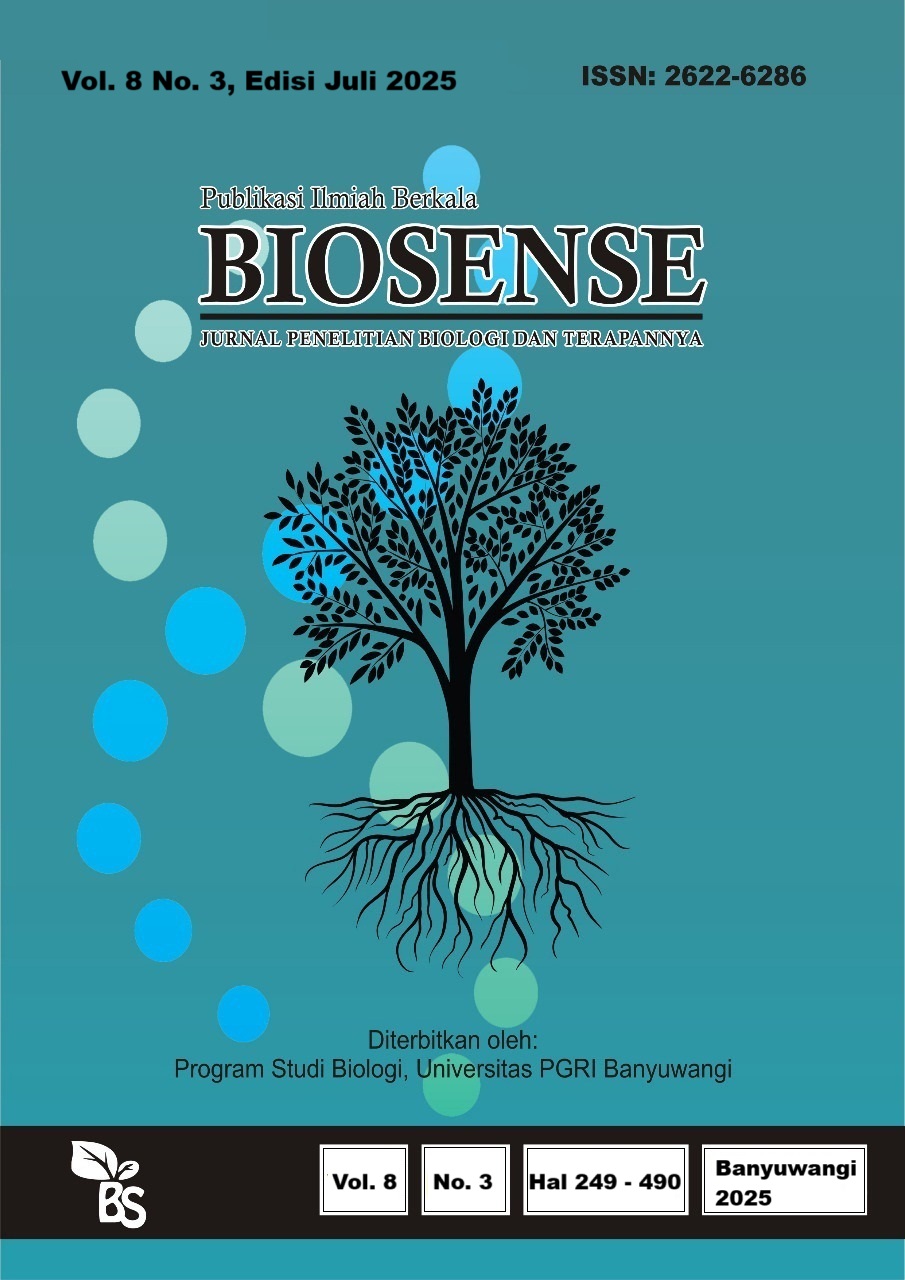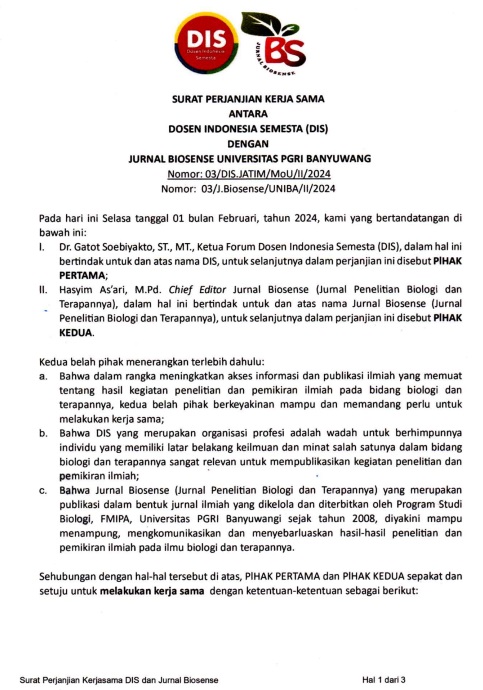IDENTIFIKASI JAMUR PENYEBAB TINEA UNGUIUM PADA KUKU KAKI PETANI DI DUSUN BAROS TIRTOHARGO KRETEK BANTUL
DOI:
https://doi.org/10.36526/biosense.v8i3.5433Keywords:
tinea unguium, dermatophytes, toenails, farmersAbstract
Tinea unguium is a type of superficial mycosis that attacks the nail plate as a result of dermatophyte infection. This study aimed to identify the fungal genera responsible for tinea unguium in the toenails of farmers in Baros Hamlet, Tirtohargo Village, Kretek District, Bantul Regency. Thirteen nail samples were examined microscopically with 20 % KOH and Lactophenol Cotton Blue preparations, and cultured on Sabouraud Dextrose Agar (SDA). Three fungal genera were identified: Aspergillus (9 isolates), Penicillium (3 isolates) and Trichophyton (1 isolate). Hence, the dermatophyte causing tinea unguium in these farmers’ feet was Trichophyton sp. Microscopic observations revealed conidiophores, vesicles, phialides, and conidia consistent with the morphological characteristics of each genus. These results underscore the need for education on preventative measures, such as wearing appropriate footwear, maintaining foot hygiene, and increasing farmers’ awareness of the risk of fungal infection.
References
Ahmed, M., Rahil Pasha, S., Hajira, S., Yadav, R. K., & Yoganand, R. (2024). Identification and speciation of fungi causing onychomycosis: A prospective study. Journal of Clinical Sciences, 21(1), 8. https://doi.org/10.4103/jcls.jcls_94_23
Chanyachailert, P., Leeyaphan, C., & Bunyaratavej, S. (2023). Cutaneous Fungal Infections Caused by Dermatophytes and Non-Dermatophytes: An Updated Comprehensive Review of Epidemiology, Clinical Presentations, and Diagnostic Testing. In Journal of Fungi (Vol. 9, Issue 6). MDPI. https://doi.org/10.3390/jof9060669
Hervina. (2022). Profile of The Incidence of Onychomycosis at RSUD Dr RM Djoelham Binjai for Period January 2017-December 2021. Science Midwifery, 10(5), 2721–9453. www.midwifery.iocspublisher.orgJournalhomepage:www.midwifery.iocspublisher.org
Kamil, Khasanah, M., Marsudi, L. O., & Sulastri. (2021). Studi Literature Agen dan Faktor Risiko Penyebab Tinea Unguium Pada Infeksi Kuku Kaki Petani. Jurnal Teknologi Laboratorium Medik Borneo, 1(1), 34–41.
Kesha, M. R., Sahputri, J., & Mellaratna, W. P. (2024). Identification of the fungi causing onychomycosis to fish traders in the fish market Lhokseumawe city Pusong. Jurnal EduHealt, 15(1), 588–595. https://doi.org/10.54209/eduhealth.v15i01
Kruithoff, C., Gamal, A., McCormick, T. S., & Ghannoum, M. A. (2024). Dermatophyte Infections Worldwide: Increase in Incidence and Associated Antifungal Resistance. In Life (Vol. 14, Issue 1). Multidisciplinary Digital Publishing Institute (MDPI). https://doi.org/10.3390/life14010001
Marcos-Tejedor, F., Mota, M., Iglesias-Sánchez, M. J., Mayordomo, R., & Gonçalves, T. (2021). Identification of fungi involved in onychomycosis in patients of a spanish rural area. Journal of Fungi, 7(8). https://doi.org/10.3390/jof7080623
Moskaluk, A. E., & VandeWoude, S. (2022). Current Topics in Dermatophyte Classification and Clinical Diagnosis. In Pathogens (Vol. 11, Issue 9). MDPI. https://doi.org/10.3390/pathogens11090957
Mulyati, Aisy, D. U. R., & Wulandari, D. (2024). Identifikasi Jamur Penyebab Onikomikosis Pada Kuku Jari Kaki Petani Sawah Di Desa Rajeg Kabupaten Tangerang. Jurnal Ilmiah Analis Kesehatan, 10(2), 136–155.
Naqsyabandi. (2021). Identifikasi Fungi Penyebab Tinea Unguium pada Kuku Kaki Petani Padi di Dusun Sekarum Desa Gandarum Kecamatan Kajen Kabupaten Pekalongan. Jurnal Medika Husada, 1(2), 19–23.
Pasande, S. (2022). Characteristics of dermatophytosis in Nabire, Central Papua, Indonesia. International Journal of Research in Medical Sciences, 10(9), 1823. https://doi.org/10.18203/2320-6012.ijrms20222253
Prabandari, A. S., Pramonodjati, F., Sari, A. N., & Cahyaningtias, A. D. A. (2024). Isolasi dan Identifikasi Jamur Penyebab Onikomikosis pada Petani di Kabupaten Sukoharjo Jawa Tengah. Indonesian Journal on Medical Science, 11(1). https://doi.org/10.55181/ijms.v11i1.470
Widaty, S., Oktarina, C., Marissa, M., Adawiyah, R., Rozaliyani, A., Kartika, E., & Tugiran, M. (2024). Clinical and microbiological characteristics of onychomycosis in a tertiary hospital: a cross-sectional study. Medical Journal of Indonesia, 33(1), 17–23. https://doi.org/10.13181/mji.oa.247201
Downloads
Published
How to Cite
Issue
Section
License
Copyright (c) 2025 JURNAL BIOSENSE

This work is licensed under a Creative Commons Attribution-NonCommercial-ShareAlike 4.0 International License.

















